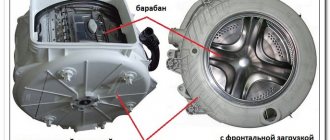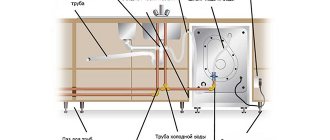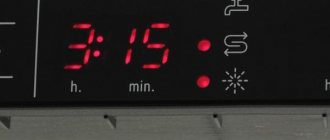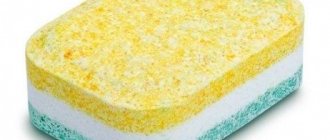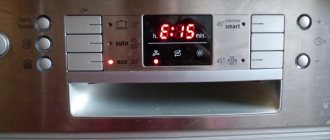Unfortunately, many people do not understand what the operating principle of a dishwasher (hereinafter also referred to as dishwashers, PMM) is. This is why there is a common misconception that household appliances are not capable of washing dirty dishes better than human hands.
Anyone who has ever tried to wash dishes in a dishwasher will no longer want to do it with their hands.
Users are confused by the fact that the dishes are simply sprayed with water with detergent dissolved in it and are not subjected to mechanical stress. Many housewives do not believe that this is how they can wash spoons, forks and plates with dried food residues. In fact, this is not the case at all. We will try to dissuade skeptics and tell you how a dishwasher works and works.
The history of the dishwasher
The first patent for a dishwashing machine was received by Joule Guoton in 1850. It was characterized by manual operation and poor cleaning process. They had already tried to create something similar before, but the attempts were unsuccessful. They never made it into history. Guotong's design was ineffective. A cylinder with a special shaft inside. Water flowed down it into buckets, which were then lifted by hand and poured out again. Following him in 1855, Josephine Cochrane acquired a patent for a new type of machine. History goes far into her past. Porcelain dishes break easily, and she had a lot of them. One day, missing a few porcelain plates, she decided to create a dishwasher. Her husband died, leaving large debts. Having taken the path of poverty, she went into a barn and came out a few months later, presenting to everyone her car, which washes the dishes itself. This version was already close to the modern one.
The drum could rotate, the quality improved, and the water was heated. But, due to the lack of repair specialists and due to the high price, it was not possible to distribute it. The maids also staged protests. Their argument was that the dishwasher was putting them out of work. In the 50s of the twentieth century, the machine began to sell well.
Financial conditions have improved, many women went out to work. Washing dishes began to take less time, and the dishwasher became a popular purchase. 1929 is famous for the creation of the first electric dishwasher.
The automatic control car was created in 1960. This option is very similar to the modern one. Dishes were being installed. Afterwards, detergent and hot water were supplied there. Next, the water was drained and the dishes were rinsed. In 1978, a touch-controlled machine was created.
Description of the processes occurring in the dishwasher
At first glance, the dishwasher is difficult to operate and contains many incomprehensible functions. In fact, this is a fairly simple device that is easy and simple to use. Just a superficial study of the functionality of the dishwasher is enough to understand the system. You also need to figure out how to properly turn on your dishwasher for the first time.
The dishwasher is controlled using buttons. First, press the wash mode selection button, then the “start” button. Next, the machine itself will complete the tasks assigned to it. You can go about your business, since it turns off itself as soon as the time comes to complete the cycle.
So, the machine is turned on. Now the equipment works strictly according to the instructions contained in it. The control unit independently switches commands and cycles, after which the water intake valve opens and tap water begins to flow into the tank.
Note! It is necessary that the dishwasher be connected using hoses to the tap water sources. All necessary components are included with the device itself.
As soon as the water is taken, mixing with special salt begins. This procedure is necessary to reduce water hardness and prevent scale formation on pipes. In addition, softened water washes dishes more effectively. At the same time, the water heating element is activated. The user can independently set the desired temperature and steam strength.
Attention! Some types of dishes are especially susceptible to water temperature and alkalis contained in dishwasher refill “tablets”.
Now it all depends on what program you installed. The washing duration and steam intensity depend on the type of programs and cycles. Let's say we insert trays and place dishes. For example, when the soaking mode is turned on, the circulation pump begins to rotate. During this process, gradually, in small portions, the pump scatters water mixed with alkali onto the surface of the loaded plates, pots and spoons. All this is necessary so that, in the process of entering into a chemical reaction, due to gradual heating, the dried dirt will become acidic. After this, the dishes will be much easier to wash.
The next stage is the primary rinsing mode. This is one of the main elements of any dishwasher cycle. The pump now delivers water mixed with the product into the sprayer, after which the acidified particles begin to be washed away from the dishes. The spray arm has the shape of a screw, and during the rotation process it fills the entire cavity of the dishwasher with small particles of water. Thanks to this system, all loaded items receive the mixture. This helps to completely wash away any dirt remaining on the surface of the dishes. From now on the plates are clean, all that remains is to rinse and dry them.
Next comes water filtration. It is not dumped, but goes back into the tank, after which all dishes are rinsed and re-treated with dishwashing detergent. This is the control stage.
The next step is for the machine to begin self-cleaning. All dirty water goes down the drain, and the system re-injects some water to flush the tank and rinse the dishes. This is necessary to wash off any remaining product.
The last stage is drying. A special screw accelerates the air, heating it to the desired temperature, which allows it to successfully dry all plates and pots.
This is how a dishwasher works. Perhaps this description seemed heavy and difficult to digest for some. In this case, you can find visual aids in the form of video instructions for operating dishwashers. In this case, you can also additionally learn safety rules, find out the causes of dishwasher malfunctions and how to avoid breakdowns in the early stages.
Water saving level in dishwashers
Both the selected washing mode and the PMM model determine how much water it will consume. On average, this is from 10 to 13 liters per procedure as a whole. Unlike manual washing, all water is used only for its intended purpose without any loss.
During the process, the working fluid is cleaned using special filters and is supplied completely renewed for rinsing. Economy modes reduce the amount of water consumed by 25%.
Water savings when using PMM are obvious. The unit uses a special technology in which the collected water is used several times
The profitability of PMM is indicated by symbols. Highly economical units are marked with the letters A, B, C. They consume 9 - 16 liters. Average-economical dishwashers are designated in the form of the letters D, E. They consume slightly more water - up to 20 liters. Low-efficiency machines with the letters F, G require 26 liters per cycle.
Features of dishwashers from famous brands
Depending on the manufacturer, the operating principle of the dishwasher may vary.
The following brands were recognized as the best in 2022:
- Bosch. Contrary to stereotypes that Bosch appliances often break down, dishwashers from this manufacturer demonstrate the opposite. The principles by which dishwashers of this brand operate is the presence of automatically configured programs for different types of dishes. In terms of technical characteristics, Bosch is not inferior to all other brands, but costs an order of magnitude cheaper.
- Siemens. This brand is trying to keep up with the times. Every year the company releases new models with updated functions. Siemens tries to combine value for money and quality, which significantly contributes to the growth of the company's popularity.
- Electrolux. The Swedish manufacturer pleases customers with a simple and easy-to-use dishwasher. In all countries where sales are made, there are sufficient numbers of service centers. Among the models of the same series, you can choose devices of different sizes and types.
- Beko. The Turkish manufacturer of household appliances and electronics is less popular than well-promoted European brands. However, it costs an order of magnitude cheaper, which, combined with high quality, makes it attractive to consumers.
- A.E.G. This brand is considered one of the best in Germany and beyond. Sensors and alarm equipment are built into the machine to prevent problems. The only drawback noted by users is the high price.
Attention! Regardless of which dishwasher company you choose, keep the coupon and sales receipt until the end of the warranty period.
Drying class
Modern dishwashers, in addition to the “energy consumption class” and “washing class,” have a parameter called “drying class.” It is determined by conducting test measurements. Depending on how much water is left on the dishes, the machine is assigned a class A, B or C.
Drying class A or B is a completely acceptable option. Class A means that the manufacturer promises us perfectly dry dishes. Classes B and C allow the presence of some moisture (drops) on the dishes.
Distinctive features of some dishwasher models
Some dishwashers have distinctive features. For example:
- Availability of a heat exchanger. This significantly reduces energy costs during drying, but takes time.
- Availability of a sensor. It determines how clean the water entering the machine is.
- The presence of a sensor that determines whether there is detergent.
- The presence of a drying sensor. It determines the level of dryness and humidity of washed dishes.
- Availability of fasteners for fragile dishes and glasses.
- Availability of a turbo drying system. It provides ultra-fast drying of dishes.
- The presence of backlight when opening the door.
- Durable transparent glass. Used as a decorative element.
- Projecting on the floor information about the remaining time.
You can additionally wash root vegetables in the dishwasher without using detergent. It is possible to wash various combs, rubber shoes, children's toys, and even cook food by simmering or steaming.
PMM washing completion time
When the dishwasher completes the wash cycle, the appliance beeps and shuts down.
The control panel contains convenient indicators for the end of the program; using the settings, you can change the volume of the sound signal or turn off the end-of-work notification.
This is especially true when loading dishes overnight.
After the machine has stopped completely, press the power on/off button.
It is recommended to wait about 15 minutes before removing dishes as they may be very hot after drying and some items may become fragile.
What items can be washed in a dishwasher?
Ceramic and metal objects can be washed in any mode. Aluminum is a rather capricious substance and contact with hot water and substances used for washing dishes can have a detrimental effect on it. In this case, there is a high probability of corrosion stains appearing. We strongly do not recommend washing aluminum spoons, pots, plates and meat grinders in the dishwasher, since in this case there is a high probability of dark spots appearing on the surface of the dishes. After this, the use of utensils becomes harmful - aluminum particles entering the body have a detrimental effect on internal organs.
If you do wash your aluminum cookware in the dishwasher and find dark spots, it’s time to treat it. Any means will do here: from toothpaste to rust solvent. The safest way is to keep the dishes in a soapy solution. Add a few drops of liquid tar soap to warm, but not boiling, water. Afterwards, dip the darkened objects into the solution. There's no time limit here, so you don't have to worry about adding too little or too much soap to the water.
The method of rubbing with soda is no less popular. A thin layer of baking soda is applied to the damp surface and, after half a minute, you can begin to rub. Remember: under no circumstances boil dishes in a soda solution. This can only worsen the condition of aluminum cookware and accelerate the processes of oxidation and corrosion.
Therefore, to avoid such situations, it is better to wash aluminum items by hand. It may take you some time, but you can avoid corrosion and extend the life of your cookware.
Dishwasher diagram
One day, every piece of household appliance will need repair. To do this, you first need to understand how a dishwasher works. Let's study its internal structure. In this case, you will clearly know what and where needs to be replaced or repaired. Dishwasher include:
- Trays for dishes
- Door closer regulating door closing speed
- Spray bar
- Thermometer
- coarse filter
- Drain hose
- Pressure regulation valve
- Drain pump for dirty water
- Storage tank
- Emergency leak protection system
- Control block
- Circulation pump
- Blocker
- Pill compartment
- Clean water injection valve
- Boiler
- Water injection hose
- Tray control levers
Sooner or later you will encounter phenomena such as technical problems or even a machine breakdown. For this case, it is best to study the diagram of the internal and external structure of the dishwasher in advance.
Some of the most common problems include valve pressure that is too high or too low. In this case, a suspicious hum comes from the machine. It often happens that when draining water, the machine makes sounds similar to creaking or squeaking. This means that the drainage system is damaged and there is a high probability that one day everything will leak. Do not ignore danger signals and take appropriate measures when one of the signs of failure appears.
How a dishwasher works
After pressing the “Start” button, a fascinating washing process begins that cannot be seen. You can only hear water being drawn, dishes being washed and dried. It's time to lift the veil of secrecy and figure out exactly how the dishwasher actually does the washing.
Useful for washing:
- water softening salt;
- detergent. Strong may be used. When washed by hand, this will most likely harm the skin of your hands. It is available in tablet or powder form;
- rinse aid
One of the advantages is that no special cleaning equipment is required: sponges, brushes. It should be remembered that loading dishes must be done according to the rules. Otherwise it will not be washed well enough.
A dishwasher is designed to hold a certain number of dishes. Usually this is from 6 to 12 sets.
Controlling the amount of loaded dishes saves energy and the amount of water supplied. By washing in the dishwasher, water consumption is reduced compared to hand washing. This happens due to the repeated use of the same water.
After loading the dishes, you need to select the desired program. The principle itself consists of certain stages following each other.
Collection and preparation of water
This is the first stage. On it, a predetermined amount of water begins to flow into the dishwasher. Most often it is cold. However, some models have connections to both cold and hot water at the same time. It passes through an ion exchanger, gets rid of unnecessary impurities, and softens. Mixed with detergent that was previously poured into the machine.
Next it heats up to a certain temperature that was set. This is facilitated by a special heating element or flow-through heater. A heating element is a heating element, like a kettle. It is able to heat water evenly. Flowing heats water faster, but also consumes more energy. Replacing the heating element will be much cheaper if it breaks.
Pressure spraying of working solution
Water, prepared in advance, enters the upper and lower sprinklers under pressure. Some models also have side ones. Thanks to the rotation of the rocker arms, water flows into all areas of the chamber, and the dishes are completely washed. There are no places where water can get in.
The dishes are wetted with a powerful stream of hot water, washing away dried food residues. The used water flows to the bottom, is filtered and re-supplied to the sprinklers. This process is repeated for the entire time specified by the program. At the end, the contaminated water is drained into the sewer, followed by clean water.
Washing and drying process
Although the process itself is completely automatic, it still starts manually.
To do this, dishes are placed in the appropriate compartments, softening salt, conditioner and detergent are loaded. Then select the program from the control panel. Next comes the dishwasher. The operating principle of any model is as follows:
- Water is collected from the water supply system.
- The water is heated by heating elements. The unit is usually connected to a cold source of water.
- Detergents, pre-filled in a special compartment, automatically flow into the sprayers located on top.
- The dishes are sprayed with jets of water supplied under different pressures and directions.
- The first portion of dirty water is drained through the system into the water supply. Then the cycle repeats.
- Now the sprayers are supplied with clean, conditioned water. It's time to rinse the dishes.
- The final stage is drying. It is this function that deserves special attention when choosing a unit. For example, condensation drying is used in almost all cheap machines. Water evaporates from the surface, settles on the cold walls of the chamber and simply flows down. The result is a rather long drying process. There is a possibility of streaks on dried plates. Turbo drying dries dishes much faster. A built-in fan is already used here. This type of drying leaves no streaks or traces of drops. However, this option consumes a lot of energy. Heat exchanger - this type of drying combines the advantages of condensation and turbo drying. A fan is not used, the process is faster, and there are no streaks left on the dishes. But cars with such a system are quite expensive.
- The design of the dishwasher also requires an indication. It allows you to verify the correctness of the selected programs and track the washing process. The machines are notified of the end of the procedure by sound and light signals. Some models are equipped with a half-beam function that signals the end of the program.
How efficient are dishwashers?
Contrary to popular stereotypes, dishwashers can easily handle any amount of dishes and any dirt. The principle of operation of a dishwasher is that the equipment can operate at any power. If a person, washing dishes with his hands, cannot accurately calculate his efforts and the required amount of product sufficient to wash a given amount of dishes, while the machine is configured for different cycles and copes with any type of dirt. Due to the use of special alkalis, the dishwasher mixes them with water. The finished substance dissolves dirt, after which it rinses the dishes, drains the water and begins the drying cycle.
Loading dishes
Before loading dishes into the dishwasher, you must first clean them of food residues and stack them. It must be folded as compactly as possible so that it does not interfere with the functioning of the equipment.
Advice! Even if some dishes are forgotten, you can open the machine doors and add the necessary items, the equipment will start again after a short time.
Now about the correct placement of specific types of dishes:
There are special containers for cutlery. Knives and forks are placed with the tip/teeth facing up.
Dishes made of fragile materials should be placed on top, and heavily soiled ones on the bottom. The dirtiest items are placed upside down.
What can't be washed in the dishwasher
Since the washing process uses hot water, under no circumstances should you place the following in the machine:
- Antique items
- Glued
- Steel
- Crystal (allowed, but with great caution)
- Cups with a pattern that cannot withstand high temperatures
- Dishes with wooden, pewter, copper, mother-of-pearl inserts
- Plastic items that are not properly labeled
- Kitchen sponges
Info! But, for example, vegetables can be safely and quite successfully washed in the dishwasher:
How long does it take to wash dishes?
A full wash cycle takes from 30 to 90 minutes. If we compare the time a person spends washing dishes with the speed of a dishwasher, the comparison will not be in favor of the dishwasher. But the use of a dishwasher is not intended to surpass a person in washing dishes. The beauty is that during this time the hostess can do other things.
How to determine the level of workload
Each dishwasher model is designed for a certain amount of dirty dishes. In order not to overload the unit, before operation you must carefully study the attached instructions prepared by the manufacturers and follow them. If the machine is overloaded, this will immediately negatively affect the cleanliness of the washed dishes.
PMM service
First of all, the surfaces of the washing chamber require care. They are made of stainless steel, which imposes certain restrictions on the cleaning products used.
Do not use products containing chlorine or abrasives. They can ruin the surface, leave permanent stains and deep scratches.
As a rule, surfaces are wiped with a soft cloth slightly moistened with a detergent solution. In most cases, manual cleaning of the washing chamber is absolutely unnecessary. It's all about the dishwashing detergents used. If high-quality products are used and the regenerating salt and rinse aid dispensers are set up correctly, the internal surfaces will be cleaned along with the dishes.
The operating instructions describe how to correctly set the salt and rinse aid consumption. It is important to understand here that the hardness of tap water and other parameters vary depending on the region, so the dosage is often selected experimentally: after completing the washing cycle, the condition of the internal surfaces is assessed, and, if necessary, the level of salt and rinse aid consumption is adjusted.
With the correct settings, the internal surfaces of the dishwasher are free of limescale, streaks and other contaminants. They remain perfectly dry and clean.
In particularly “neglected” cases, wipe the walls of the chamber with a soft cloth soaked in table vinegar. Or, place a container (100-150 ml) with vinegar in one of the baskets of an empty dishwasher and start the washing cycle, after which the walls of the chamber are washed with dishwashing detergent.
The rubber seals on the car door deserve special attention. Limescale deposits accumulate on them, interfering with a normal fit.
Such contaminants are removed with a sponge or rag soaked in table vinegar.
To prevent corrosion on dishwasher baskets made of enameled metal rods and other elements of the dishwasher, it is recommended to wipe them dry after each use.
To prevent condensation from forming inside the compartment, leave the door open until the dishwasher has completely cooled down.
If you are using a non-built-in (free-standing, tabletop) dishwasher model, the user’s attention will also be required on its outer surfaces. They are cleaned with a slightly damp sponge or cloth soaked in a cleaning solution.
Like any other equipment, a dishwasher needs proper and regular care. Maintenance and care procedures are simple and will not take much time, but if you ignore them, the dishwasher will turn into a piece of furniture and will no longer be able to perform its direct functions.
Selecting work programs
The best washing effect is provided by the ECO (economical) program, but if the dishes are heavily soiled, you should still choose “intensive washing”.
For washing fragile dishes, a delicate mode is used, which differs from all others in that the water temperature will rise during the first rinse. By the way, this same mode is also suitable if the dishwasher contains dishes of completely different types and materials.
Important! It is impossible to tear off the machine immediately after the last cycle is completed. It is recommended to wait about 25 minutes more to allow the dishes to cool down.
Finally, it should be noted that you need to wash the machine, or rather its filters, after each start; to do this, it will be enough to wipe them with a damp washcloth. We should not forget about the sprinkler nozzles; it is very important to ensure that they are not clogged.
Main components of a dishwasher
The design of any dishwasher consists of the following components.
- Control block.
- Control panel with display. Allows you to perform all the necessary equipment settings.
- Water sprinklers. As a rule, most machines have upper and lower versions.
- Inner chamber. It contains baskets for dishes and the entire washing process takes place.
- A filter that purifies the water supplied to the device.
- Waste water filter. Necessary for retaining food debris.
- Sensors that monitor the temperature and liquid level inside the sink.
- Instantaneous type water heater.
- Ion exchanger. The resin contained in it allows you to soften too hard water.
- A circulation pump that supplies water to the washing chamber.
- A sump pump that discharges wastewater into the sewer system.
In addition, some modern models are equipped with a heat exchanger and a fan for faster drying of dishes.
The chamber for dishes is made of stainless steel. This allows for greater durability of the equipment. In addition, machines can wash not only plates, but also larger dishes - pots and pans. This is why the trays are made removable. The hatch cover of any model of equipment has a rubber seal along the contour, ensuring tightness and reducing noise levels. There is also a container for detergent on it. In modern machines, the use of powder, tablets or liquid formulations is allowed.
Operating rules
Even if the design of the dishwasher provides for the supply of hot water, you still should not connect it to the hot water supply. Firstly, the quality of hot water is lower than cold water, so the filters clog much faster. Secondly, components used for hot water fail faster than those used for cold water. Therefore, you will have to change hot water hoses much more often.
When using a dishwasher, you can save energy. To do this, wait until the washing procedure is completed and turn off the machine. Open the door and wait for the dishes to dry naturally. Thus, by not turning on the electric heating elements during drying, significant savings can be achieved. This operation is performed if there is no need to quickly complete washing.
Options for drying dishes in the dishwasher
Currently, a drying mode is provided in almost all models. The only exceptions are the most budget cars. In other cases, drying dishes is carried out in the following ways:
- using a heat exchanger (condensing);
- heated coil and fan (turboblowing);
- zeolite block.
The heat exchanger is a plastic container with cold water inside. Here the principle of operation is based on the fact that after washing the dishes, all remaining water evaporates and settles in the form of condensation on the surface of this block. Of course, this drying method takes a lot of time, but it does not require any energy consumption.
Using a fan will dry dishes much faster. However, this method is energy-consuming. In addition, when choosing a machine, you need to pay attention to the sealing ring of the hatch cover. It should not only prevent leaks, but also help reduce the noise level when the fan operates.
Ion exchanger with salt - principle of operation and purpose
Some dishwasher owners mistakenly believe that sodium regenerating salt and detergent are the same thing. However, these compositions perform different functions, and in addition, they are poured into different containers. The powder is poured into a container located in the hatch of the device, salt is added to the reservoir located at the bottom of the washing chamber.
Of course, you can find special “tablets” that already contain the required amount of salt. This product is placed in the dishwasher lid reservoir. But if the tap water is too hard and contains a large amount of calcium and magnesium, then it is advisable to use a special salt composition for the ion exchanger. Otherwise, the device will fail quite quickly.
Every dishwasher has an ion exchanger. It contains a resin consisting of sodium chloride. Water intended for washing dishes from the water supply first enters the ion exchanger, where sodium ions replace calcium and magnesium contained in the liquid. This chemical reaction allows you to avoid the formation of scale on machine parts, as well as the appearance of stains on washed dishes.
As the device operates, the sodium salt is gradually washed out of the unit. In this case, it is necessary to use special dishwashing compounds in which the NaCl content exceeds 99% to add a new portion. The use of ordinary table salt is prohibited.
The consumption of sodium salt depends on the operating mode of the machine. Most often it can be configured manually. However, in the future you will have to constantly monitor the composition of the water and, if necessary, make additional adjustments.
Advice! To simplify your task and eliminate the need for manual adjustment, it is recommended to immediately purchase devices complete with a stiffness sensor. In this technique, all settings are done automatically, and salt consumption will be as economical as possible.
You might be wondering: how to choose a dishwasher.
How does a “dishwasher” work?
To better understand what happens inside the dishwasher during operation, you need to study its structure. If we disassemble a dishwasher and look at its structure from the inside, we will see a system of units and sensors interacting with each other. Although the machine’s structure is not complicated, if you are going to disassemble it for the first time in your life, record your actions on video. The video will help you then correctly put all the parts in place after the repair work has been carried out.
The main parts of the dishwasher are located in the lower part of the body; from the inside it looks quite interesting. In the bowels of the body there is:
Here is a general list of elements installed in the dishwasher. You can see where and how they are installed in the picture above. If this is not enough to understand the overall picture, you can find a video on the Internet that demonstrates the details of the dishwasher.
Why does the “dishwasher” wash even very dirty dishes?
Now let's dispel the myth about the inefficiency of the dishwasher. Numerous tests, both in laboratory conditions and in the conditions of an ordinary average apartment, confirm that the “dishwasher” is quite capable of caring for a whole mountain of dishes. Why does she do this? There are at least three good reasons:
- washing dishes is done using a solution of special salt and detergents that dissolve food residues and grease;
- washing takes place in water heated to the optimal temperature;
- the dishes are sprayed with water, which is supplied under high pressure in a fan-shaped manner, which allows you to spray all the items to be washed from all sides.
Of course, if you stuff a pan with a centimeter layer of burning into a dish tray, it is unlikely that the dishwasher will cope with such contamination. However, it is reliably known that after a washing cycle, even such dirt is greatly softened from the inside and can then be removed manually using a small amount of an abrasive cleaner. In general, we can say without exaggeration that a dishwasher is one of the most necessary household appliances in the kitchen, and if this story does not convince you, read
You load dirty dishes into the dishwasher, press a couple of buttons, the device works, and then you take out clean ones - this is how a household dishwasher works. However, not everyone knows how everything works from the inside. Let's figure out how dishes are “washed” in the dishwasher chamber. The following describes the technology in simple language, which is accessible to everyone.
Practical rules for operating the device that you will not find in the instructions
Using the device as written in the instructions is the key to quality work. However, it is not always possible (or desire) to read it. Therefore, we share important tips and nuances of operating the unit:
- The dishwasher is not intended for washing wooden products. Also be careful when washing ceramics, silver and brass. But glass and crystal can be loaded into the device without fear that they will break. A special program is provided for them.
- Place sharp objects in specially made compartments in the basket or in the top box. It is important that they do not interfere with the movement of the rocker arms.
- Lock the unit during operation to avoid the risk of burns.
- Do not open the door immediately after washing has finished. Let the dishes cool down a bit.
If you want to wash dishes with detergent that you use to wash dishes by hand, then remember that it should not foam much. Because it will damage the device. It is not recommended to immerse ordinary or laundry soap into the unit as a detergent. Under no circumstances should you set the drying mode if you put plastic dishes in the sink. As a result, it can either leak or become very soft.
If you see food residues on the bottom of the device after the device has finished operating, then you need to clean the drainage filter. To make it less clogged, you need to clear the dishes of food before loading.
Problems in the operation of the dishwasher, ways to solve them
It often happens that a program starts, the indicator lights up, water is poured into the machine, and it works for the required time. But then it turns out that the dishwasher doesn’t wash the dishes, but just hums. This can happen due to a clog in the filter at the bottom or in the nozzles. Simply rinse the filter or clean the nozzles with a toothpick. This can also be caused by a breakdown of the circulation pump. In order to repair it, you need to disassemble the device. It is better to call a specialist for this. The problem may also lie in the motor winding. You need to check the unit with a multimeter for short circuits or network breaks.
- If water overflows in the machine, then its water sensor is broken. It's at the bottom. It must be replaced with a new one.
- And if water fills in when the machine is turned off, then the solenoid valve needs to be replaced.
- If too cold water is poured into the machine, and a special sensor reports this, you need to check the serviceability of the heating element, the correct pressure in the chamber and the operation of the sensor itself.
- If water does not drain from the device, the drain pump may be broken. And if some of the water leaves, but some remains, then you need to figure out how to connect the hose. Also make sure there is no blockage in the drain pump.
- The dishwasher can shock you if there are cracks or damage to the heating element. Inspect it and replace if necessary.
- If the dishwasher does not pick up detergent, then you need to clean the nozzles and check the water pressure.
- The fact that the device began to make a lot of noise was due to the bearings and electric motors. You also need to check the seal.
- Water leakage can be caused by damage to the connections, pipe, hoses, side tank or door seal.
What to do if the dishwasher doesn't work well?
If you still managed to start the unit, but it is obvious that it is not working correctly or is not performing its functions, the closest attention should be paid to the following points:
- Knocks and other extraneous sounds when equipment is operating
The integrity of the nozzle bearings should be checked. The bearings of the main or drain pump unit may also knock. The first works periodically, pumping water into the system, the second - at the end of each cycle.
- Water does not enter the working chamber
If the filter and water supply hose have nothing to do with it, most likely the culprit is a broken inlet valve that needs to be replaced.
Dishwasher inlet valve
- Pressure switch does not work
You need to remove the terminals from this part and clean the pipe to which the plastic pressure tube fits - a working switch, when triggered, makes a soft click.
- The machine stops mid-cycle
The reason for this is most often a faulty pump. But first you should check the recirculation filters, water intake path, water heater or thermostat.
Dishwasher circulation pump
- Dishes are washed with cold water
Most likely, your machine does not have a temperature sensor, so its programmer did not notice that the heating element or heating automation was out of order. In this case, you will have to replace the broken electronics, which is recommended to be done at a service center.
Conclusions and useful video on the topic
To understand the structure of a dishwasher in more detail, watch the videos below. We specially selected them to make it easier for you to understand the principles of PMM operation.
The video clearly demonstrates the design features of the dishwasher:
Operating principle and analysis of typical PMM modes:
The video introduces the main operating components of dishwashing equipment:
It is not difficult to understand how the PMM works and is structured. This knowledge will help when choosing suitable dishwashing equipment and will allow you to avoid serious mistakes during its operation. Information about the design of the dishwasher will also be useful if you need to quickly replace parts or if you have to independently find out the reasons for the breakdown of the machine.
Do you still have questions about the design of the dishwasher or one of its working units? Please check all the details with our experts in the comments section.
What should you pay attention to when choosing technology?
When choosing the optimal machine model, it is important to take the time to study the capabilities and characteristics of the offered equipment. In addition to class, size and installation method, several other aspects matter.
The material from which the tank, rocker arms and baskets are made affects the durability of the units. It is important that as few parts and assemblies are made of plastic.
The capabilities of the technology and its contents are also important to the user. Various modes allow you to better cope with the task. For example, the “soaking” mode helps to more effectively wash off dried dirt.
Dishwasher washing modes are described in the instructions
An installed system for determining the degree of water purity is necessary for the control unit to make a decision about draining the water or reusing it. Built-in drying is also very useful for owners. In everyday life, it is convenient to wash dishes with a half load.
Dishwasher Whirlpool ADPF 851 WH
Models are available with mechanical or electronic control. Most modern equipment is equipped with the second option, although it is considered less reliable.
BEKO DSFN 6530 dishwasher control panel
The noise level produced by a running unit is often of great importance. Especially for families with small children. It can vary in the range of 38...55 dB. To prevent the machine from causing inconvenience, it is better if the indicator does not exceed 45 dB.
The reliability of equipment is largely determined by the country of manufacture and manufacturers. Products manufactured by Miele, Electrolux, Bosch or AEG have long been proven for their quality.
Video - Electrolux ESF45055XR dishwasher
Of course, these brands cost a lot. Italian technology also performs well.
Italian kitchen appliances Smeg
Many people are suspicious of the products of Chinese factories, but recently decent models can be found in this segment.
Xiaomi smart dishwasher


